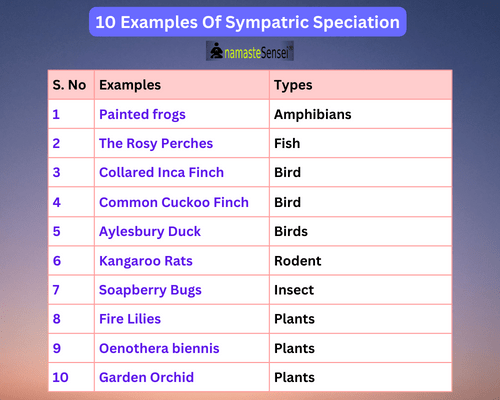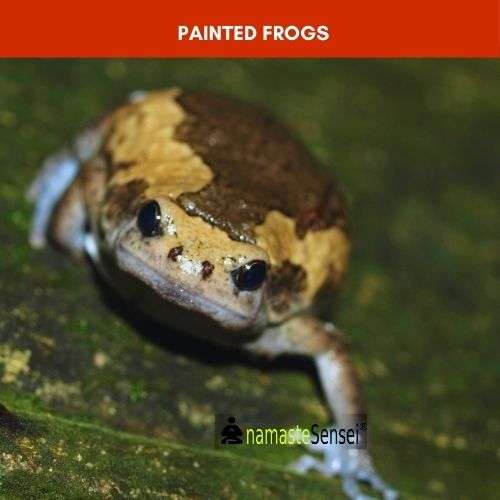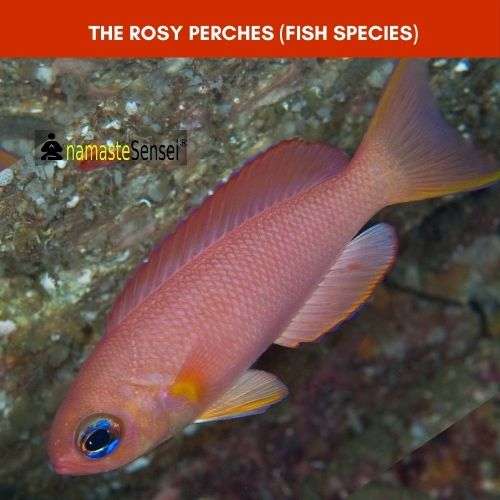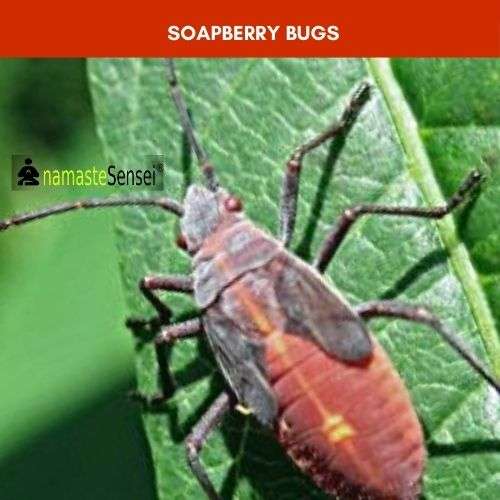Sympatric speciation examples | 10 Examples of Sympatric Speciation

Write Some Examples of Sympatric Speciation In Plants and Animals Species.
Sympatric speciation, or the evolution of new species within the same geographic area, has fascinated biologists since Charles Darwin first theorized about it in his book On the Origin of Species.
Sympatric speciation, the formation of new species without geographic separation, is an understudied but fascinating phenomenon that occurs in plants, insects, amphibians, and other organisms on Earth today. What are some of the most exciting examples of sympatric speciation? I’ve collected ten of my favorites to share with you below. Enjoy!
10 Examples of Sympatric Speciation In Plants and Animals & Birds Species

Examples
Here are the 10 sympatric speciation examples of plants, animals, and birds.
- Painted frogs
- The Rosy Perches (Fish Species)
- The Collared Inca Finch – (Bird)
- Common Cuckoo Finch – (Bird)
- Aylesbury Duck
- Kangaroo Rats in California and Nevada
- Soapberry Bugs
- Fire Lilies (plants)
- Evening Primrose (Oenothera biennis) – Plant
- The Garden Orchid (Dendrobium bigibbum) – Plant
-
Painted Frogs

Many species have a variety of color patterns. For example, the Painted Frogs in Australia come in many shades, like brown and black, but also yellow and green. This is a result of sympatric speciation. Sympatric speciation examples are formed when members of one species become divided by habitat differences that are too large for them to cross, leading to reproductive isolation.
Even though the frogs live in different environments, they still share the same geographic region and can breed with each other if they find themselves on opposite sides of the area’s natural barriers.
-
The Rosy Perches (Fish Species)

One of the most famous examples of sympatric speciation is the Rosy Perches, a case where two populations of fish living in lakes in Eastern Canada independently developed different colorations. The red population has reddish scales while the blue population has bluish scales.
It’s unknown what factors caused the change from one color to another, but it could be related to an adaptation to living in different habitats or eating different prey. This example shows how a new species can emerge with no physical contact between two populations that are geographically close together.
-
The Collared Inca Finch – (Bird)

A recent example of sympatric speciation is the Collared Inca Finch. The Collared Inca Finch used to live in Peru (South America), but it traveled north and settled in Colombia. In its new home, it quickly thrived and evolved into a new species – the Coastal Inca Finch. One way that the two species were able to become distinct was by changing their beaks based on what they ate.
For example, if the Coastal Inca Finch needed something harder to break down its food, it would have a thicker beak than if it didn’t need one. This specialization helped make sure each species could survive in their different environments.
-
Common Cuckoo Finch – (Bird)

Another sympatric speciation example in birds is the Common Cuckoo Finch. The Common Cuckoo Finch’s primary host is the weaver finch, and it is an obligate brood parasite. This brood parasite will lay its eggs in the nest of a weaver finch and then leave, knowing that the finches will raise their chicks as if they were their own.
The adult Common Cuckoo Finches can recognize which nests belong to weaver finches and which do not because they have learned to listen for the typical call that weaver finches used to warn one another when they see a cuckoo coming.
-
Aylesbury Duck

While sympatric speciation is less common than allopatric speciation, it happens in some species. One example is the Aylesbury Duck, which was created through a cross between a male mallard and a female Muscovy duck.
This new breed had three-quarters of its genes from the mallard, but because they were raised by their mother, the Muscovy duck, they looked just like her species.
-
Kangaroo Rats in California and Nevada

A recent study on the Kangaroo Rat, Dipodomys ordii, found that these rodents are undergoing sympatric speciation. What does this mean? This means that as the rat is evolving to suit the environment in which it lives, its evolution is happening in one region and not migrating to other regions. The rat’s evolution is happening so rapidly and consistently that there are two different species of rats within a few miles.
This type of speciation is called sympatric speciation because it occurs when closely related species live together but do not interbreed. For example, in Australia, there are over 400 endemic rodent species; they all came from just one ancestor!
-
Soapberry Bugs

This is a fascinating story about how, over time, two different species have evolved as they live on the same island. This is a sympatric speciation example of how evolution can happen quickly in just a few generations. Soapberry bugs are insects that feed on soapberry plants.
One species (genus) feeds on the fruit pulp but not the seeds, while the other species feed only on seeds. The two species feed together and breed together for many generations until they eventually became two different species with specialized diets.
-
Fire Lilies (plants)

These flowers can grow anywhere from 6 inches to 9 feet tall, and they live on both sides of the Pacific ocean. Despite living on opposite sides of the world, the fire lilies share an identical genetic structure. How is this possible?
Scientists believe that these two populations developed independently for thousands of years and are now living close enough together so that their pollen is able to fertilize one another’s flowers.
-
Evening Primrose (Oenothera biennis) – Plant

Evening primrose is a type of flowering plant that is native to North America. It has been introduced as an ornamental species throughout much of the world. The plants are large, herbaceous perennials, with flowers that open at night and close during the day.
There are several varieties, including variegated evening primrose (Oenothera speciosa), which has yellow and white stripes on the leaves; showy evening primrose (Oenothera biennis) which is a large variety with purple-tinted foliage; and prairie evening primrose (Oenothera fruticosa) which is a smaller variety with broader, shinier leaves than most other varieties.
The populations of these three types occur together in various locations throughout North America. In certain areas they have found that the three types do not interbreed – they exist side by side but cannot cross-pollinate each other without human intervention – this is evidence of sympatric speciation occurring because of the environment shaping the genetic makeup over time into separate populations with no interbreeding taking place.
-
The Garden Orchid (Dendrobium bigibbum) – Plant

The Garden Orchid is a popular plant for gardeners and collectors, with there being over 750 different varieties. We can find this orchid in tropical regions all over the world. The variety I am most interested in is the Dendrobium bigibbum.
This orchid has been extensively hybridized and there are many variations that have been created by crossing this species with other related species. These crossings have led to new species such as Dendrobium tetragonum, Dendrobium pendulum, and Dendrobium monophyllum.
Congratulations, you have read the complete article about the 10 Fascinating Examples of Sympatric Speciation. If you have any doubts or queries, feel free to comment below. We will respond as soon as possible.
Or Email Us At [email protected]
Any topic you want us to cover? Let us know.
